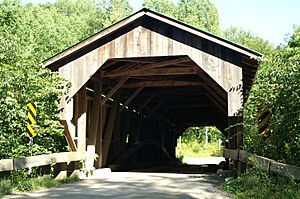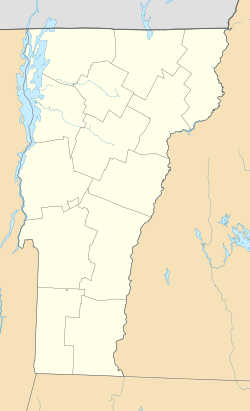Grist Mill Covered Bridge facts for kids
Quick facts for kids Grist Mill Covered Bridge |
|
|---|---|
 |
|
| Carries | Automobile |
| Crosses | Brewster River |
| Locale | Cambridge, Vermont |
| Maintained by | Town of Cambridge |
| ID number | VT-08-01 |
| Characteristics | |
| Design | Covered, Burr arch |
| Material | Wood |
| Total length | 84.5 ft (25.76 m) |
| Width | 13.7 ft (4.18 m) |
| Number of spans | 1 |
| Load limit | 5 tons |
| Clearance above | 9.75 ft (2.97 m) |
| History | |
| Constructed by | unknown |
| Construction end | c.1872 |
| Area | 1 acre (0.40 ha) |
| NRHP reference No. | 74000225 |
| Added to NRHP | June 13, 1974 |
The Grist Mill Covered Bridge is a special old bridge in Cambridge, Vermont. It's also known by other names like the Scott, Bryant, or Canyon Covered Bridge. This bridge carries Canyon Road over the Brewster River.
It's a covered bridge, meaning it has a roof and walls. This helps protect the wooden structure from weather. Built a long time ago in the 1800s, it's one of the few bridges left in Vermont that uses a unique design called a Burr arch truss. In 1974, it was added to the National Register of Historic Places, which means it's an important historical site.
Contents
What Makes the Grist Mill Bridge Special?
The Grist Mill Covered Bridge is located near Jeffersonville. You can find it on Canyon Road, just off Vermont Route 108. The bridge crosses the Brewster River and is built on strong supports made of stone and concrete.
How the Bridge is Built
This bridge uses a special design called a Burr arch truss. Imagine a strong arch made of wood, combined with a framework of vertical posts and diagonal braces. This design makes the bridge very sturdy.
- The bridge is about 84.5 feet (25.8 m) long.
- It's about 17.5 feet (5.3 m) wide in total.
- The part where cars drive is about 14 feet (4.3 m) wide, which is enough for one lane of traffic.
The roof is made of metal and has a pointed shape, like a house roof. This roof sticks out a bit past the ends of the bridge. The outside walls are covered with vertical wooden boards. These boards also cover the inside of the openings where you drive in and out.
Unique Features of the Bridge
If you look closely at the long sides of the bridge, you'll see two rectangular window openings. These let some light into the covered space. The floor of the bridge is made of wooden planks.
The Grist Mill Covered Bridge is one of only three covered bridges in the town of Cambridge. It's also one of just nine Burr arch bridges still standing in the entire state of Vermont!
History and Restoration of the Bridge
This bridge was originally built near a grist mill, which was a place where grain was ground into flour. Over time, the bridge was used less often. By 1974, when it was listed on the National Register of Historic Places, it needed some repairs.
Bringing the Bridge Back to Life
In 2001, engineers studied the bridge and decided it needed a big fix. This was to make sure it could safely carry traffic again. In May 2004, a company called Blow & Cote Contractors started working on it. They carefully repaired and strengthened the bridge. The Grist Mill Covered Bridge was reopened to traffic on October 13, 2004. Now, it continues to serve the community and stands as a reminder of old building methods.



